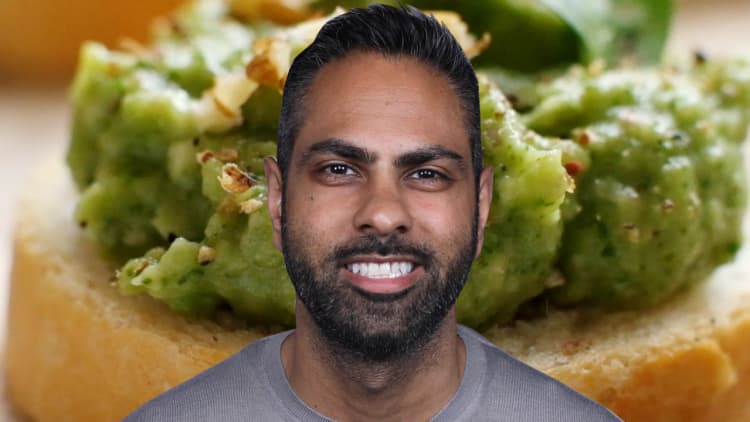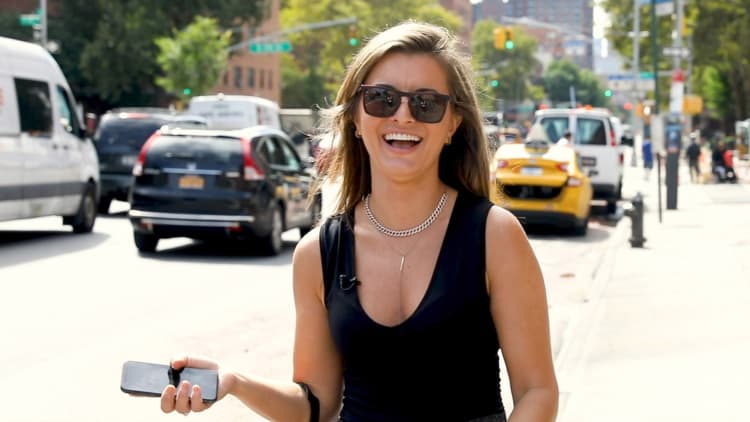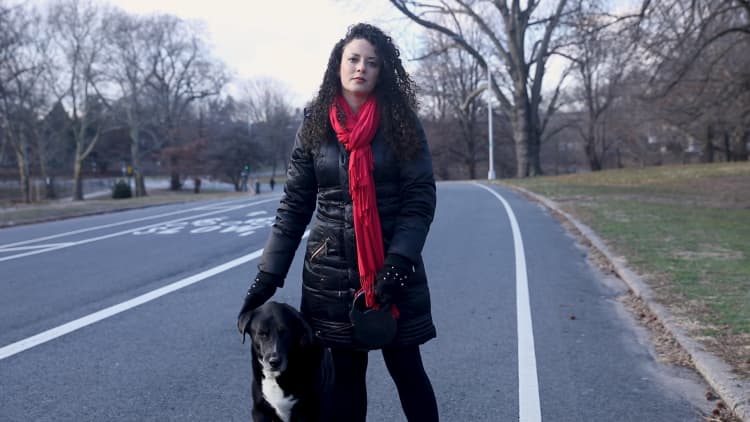This story is part of CNBC's Millennial Money series, which profiles how people across the U.S. earn, spend and give away their money.
Jessica Brodkin has had a diverse career: She's worked in multiple states and industries, learned the art of relieving pain and even healed celebrity clients. The 37-year-old's professional credits include over a decade as an analyst at the CIA, on and off periods as an actress and comedian, and building her own business as an energy healer.
Now she earns $108,000 a year doing Reiki in New York City. On the side, she still does some stand-up comedy shows, as well as speaking engagements. She's also working on a short film and developing a live show that combines group healing, comedy and music.
At the same time, she prioritizes giving money to charity every month and taking care of her 12-year-old black lab mix, Julius.
She acknowledges that it's a lot. "I often feel like I have this creative current running through me, almost like a fire running through me, and I have to get things out," she says.
What she earns
After graduating from MIT at age 22, Brodkin was recruited into the CIA. She spent 11 years as an analyst there before she finally got the courage to quit and pursue one of her passions: stand-up comedy.
Leaving the CIA also meant leaving her steady, $80,000-a-year salary. Brodkin didn't earn much from comedy — only around $3,000 a year — and supplemented her income with acting gigs. She also relied on credit cards to make ends meet, and she racked up several thousands of dollars in debt.
About seven years earlier, when she was 26, Brodkin first discovered Reiki, a kind of energy healing. At the time, she was on medical leave from work due to debilitating health problems. "I had migraines, pseudo-seizures and depression, and I was not able to function," she says. "I ended up passing out at a friend's house from a migraine. I woke up and he was waving his hands over me, and I felt better."
Although Brodkin had never heard of Reiki, after experiencing the way it wiped out her pain, she wanted to learn more. As her interest developed, she began practicing on family and friends. She noticed a powerful improvement in her own health as well.
"I had a physical and mental breakdown around [age] 31 and then, once I got healthy, I was meditating constantly in the woods of Virginia," she says. "After that, I realized that I was able to heal, that I was able to do healing work, and so I started working on my family and my friends."
In 2015, she launched an official Reiki business on the side. Word spread, and she started seeing more and more clients. "This healing business really took off, and it was kind of an accident," she says. "It was not planned."
Even as her Reiki practice grew, Brodkin continued doing stand-up, auditioning for acting gigs and living primarily off her savings. At one point, she got into a fight with her manager because he would book her auditions, but she refused to cancel time with her Reiki clients to go to them.
So, three years ago, she decided to make healing her full-time job. In 2018, she brought in $108,000.
She currently sees 12 clients per week from a Manhattan coworking space, and sessions typically last 75 to 90 minutes. She charges $229 per session but offers a discount to clients who purchase multiple sessions at once. The rest of the time, she works on marketing, responding to emails, speaking with prospective clients, developing online tools for clients and more.
I often feel like I have this creative current running through me, almost like a fire running through me, and I have to get things out.Jessica Brodkin
"I haven't even thought about how many hours I spend on my business," she says. "It feels like it's always on my mind, so it almost feels like I don't take time off."
She says she's worked on a handful of celebrities, including Emma Stone and Jerry Stiller, but the majority of Brodkin's clients are normal, everyday people. "The clients are really diverse," she says. "I've had people who are doctors and lawyers and that sort, and I've had people who are health coaches and entrepreneurs and artists and filmmakers."
She's also noticed Reiki gaining mainstream appeal: "It's becoming a little bit less weird for people."
What she spends
Here's a breakdown of everything Brodkin spends in a typical month.
Click to enlarge
Rent: $2,280
Brodkin lives in a one-bedroom apartment in Brooklyn, New York, with her dog. Although her rent is high, Brodkin says it's worth it. "My friends who don't live in New York City think that my rent is insane," she says.
She wants to own her own home one day, but saving up for a down payment isn't a financial priority right now: "I would love to buy property in New York, but I don't know how that's going to happen. It's going to take Moses parting the sea or something," she says.
Utilities: $140
That includes around $85 per month on Wi-Fi and $55 on electricity and gas for her apartment.
Insurance: $400
Brodkin pays $270 a month for health insurance, which also covers dental and vision.
Car insurance costs her another $130 per month.
Therapy: $700
Counseling is a major expense for Brodkin, but it's a priority that she takes seriously. "My therapist is $700 a month, which I have a hard time paying mentally, but I need to do it," she says.
Food: $800
Between groceries and dining out, Brodkin spends around $800 per month on food. She aims to cook most of her meals herself, but ends up dining out for lunch three to four times per week when she's in the office. She'll also go out to dinner about once a week.
"I have the 'we have food at home' conversation with myself all the time," she jokes.

Transportation: $160
Because Brodkin owns a car, she doesn't purchase an unlimited monthly subway card. Instead, she ends up spending around $25 a month on gas and $80 on public transportation.
She also puts about $700 a year toward car maintenance, which averages out to around $55 per month.
Debt repayment: $700
When Brodkin left her job at the CIA to strike out on her own, she didn't have a back-up financial plan. To make ends meet, she relied on her savings and credit card, which resulted in a significant amount of debt.
Brodkin has around $10,000 left to pay off, but she was able to negotiate the interest rate down to zero percent. She hopes to fully eliminate her debt in about a year.
Donations: $100
Brodkin gives $100 a month to Feeding America, a non-profit that supports food banks, soup kitchens and shelters across the country.
Pet expenses: $400
Brodkin dedicates a decent portion of her monthly income to her dog, Julius, a black lab mix who's nearly 12 years old.
Julius's monthly expenses include about $60 for food, $80 on a dog walker, $130 for vitamins, including CBD oil, and $100 for pet insurance. Brodkin also pays between $200 and $500 annually for vet check-ups, which averages out to around $30 per month.
Business expenses: $1,840
The biggest monthly expense for Brodkin's Reiki business is an office in Manhattan, which she uses to see clients. It typically runs her about $1,675 per month, although it can vary depending on how busy she is. The office is part of a coworking space, so she's charged based on how much she uses it. The more clients she sees per week, the more she pays.
Brodkin also pays for a number of services that she uses for marketing, communicating with clients and expanding her business. That includes $13 for GoDaddy, $17 for Zoom, $76 for Constant Contact and around $50 on supplies, including plants, herbs and crystals. She pays $100 per year for business insurance, which averages about $8 per month.
She has a separate bank account for work, which she uses to keep her business expenses separate from her personal ones. However, her income stems directly from how much is left at the end of the month after paying all of her bills.
She doesn't pay quarterly taxes but is careful to put away 10 percent of everything she makes to cover her tax bill in April. Brodkin works with an accountant who ensures that all of her business expenses are handled properly.
Everything else:
- Phone: $110
- ClassPass: $78
- Netflix: $10
- Amazon Prime: $119 for an annual subscription
- Medium: $5
What she saves
Currently, Brodkin doesn't have any money in a retirement fund. She cashed out everything she had saved while working for the government to help sustain her when she wasn't earning a steady paycheck. Now, she's focused on rebuilding those savings and making retirement a priority.
This year, her goal is to max out her Roth IRA. For 2019, the contribution limit is $6,000, up from $5,500 in 2018.
The amount Brodkin contributes to her personal savings account fluctuates month to month, depending on how well business is going. In a slow month, she'll only contribute $500, but during particularly lucrative months, it could be between $2,000 and $3,000.
She also wants to build up an emergency fund with six months' worth of living expenses in place.
What the experts say
CNBC Make It asked Pamela Capalad, a certified financial planner and the founder of Brunch & Budget, to comment on what Brodkin is doing well and how she could improve. Here are her thoughts:
She's smart to keep her business expenses separate
Although the overhead for Brodkin's business is part of her monthly and yearly budget, she separates her work from her personal expenses. Brodkin has an independent bank account for her business, keeps detailed books and works with an accountant.
This separation is a smart choice, especially for tax purposes, Capalad says.
"The thing about being a freelancer is your tax situation is so much more complicated," she says. "Having a separate business account and knowing how much income is coming in and how much income is going out on a regular basis will help you track how well your business is doing."
It will also make things easier if Brodkin is ever audited. "As sole proprietors, you're more likely to be audited than a corporation, so if you do get audited and you want your books to be clean, the best way to do it is just to start now," Capalad says. "It's better for you in the short-term, and it's better for you in the long-term."
It might make sense to switch to paying taxes quarterly
Technically, freelancers and self-employed people are required to pay taxes quarterly instead of annually. If they don't, they're charged a penalty. Depending on how much you earn, that penalty can be small enough that it feels negligible, Capalad says.
But for Brodkin, who brought in more than $100,000 last year, it's worth asking her accountant how much she could potentially save. Especially since Brodkin already sets aside money for taxes and is "judicious" about bookkeeping, as she puts it, it makes sense to get it out of the way and save a little money at the same time.
She's not living based on the highs and lows of the business, which is really awesome. It would be good to acknowledge that by sending money to herself.Pamela CapaladCFP and founder of Brunch & Budget
"It's a little extra administrative thing, but not having to owe that much money at tax time and not having to pay penalties is a big reason why" it's worth it, Capalad says.
It's great that she's focused on saving
Although the amount Brodkin puts into savings varies month to month, Capalad says it's great that she makes it a habit and is thinking about the future. She's also smart to put away a portion of her income for taxes so she's not caught off-guard by how much she owes.
If Brodkin wanted to take things a step further, she could consider paying herself a set amount every month. It would not only make it easier to budget and save, Capalad says, but it's "a marker of financial stability."
"She's not living based on the highs and lows of the business, which is really awesome," Capalad says. "It would be good to acknowledge that by sending money to herself."
She might be able to save more with a SEP IRA
Capalad applauds Brodkin's goal to begin rebuilding her retirement savings, but wonders if she might be able to save more by using a SEP IRA, or simplified employee pension, instead of a Roth IRA.
A SEP IRA allows self-employed workers to make tax-deductible contributions and not have to pay taxes until they retire. They also offer higher contribution limits: For 2019, you can contribute up to 25 percent of your income after deductions, or as much as $56,000.
While both SEP and Roth IRAs can be powerful retirement planning tools, for self-employed freelancers and entrepreneurs like Brodkin, a SEP could offer more overall savings. It's worth asking her accountant to calculate the difference.
Disability insurance could offer peace of mind
Because Brodkin's Reiki practice heavily relies on her ability to be present and move around with her clients, she might want to consider looking into disability insurance, which kicks in if you're injured or have a long-term illness, Capalad says.
"It protects your income," she explains. "If you weren't able to work, you could get a disability payment for up to 50 percent of your salary for a period of time."
While coverage will vary policy to policy, it's a good idea to have a backup plan, especially if you work for yourself. Plus, Capalad says, it's typically not very expensive, especially if you're able to get a group rate, like the one available through the freelancer's union.
It's okay to spend on mental health
While some people might gasp at the $700 Brodkin spends out-of-pocket on therapy each month, Capalad commends Brodkin for prioritizing her mental health.
"It's also very in line with her work and what she does," Capalad says.
What's your budget breakdown? Share your story with us at makeitcasting@nbcuni.com for a chance to be featured in a future episode.
Like this story? Subscribe to CNBC Make It on YouTube!
Don't miss: Here's the budget breakdown of a 34-year-old who makes $150,000 and is excellent with money




